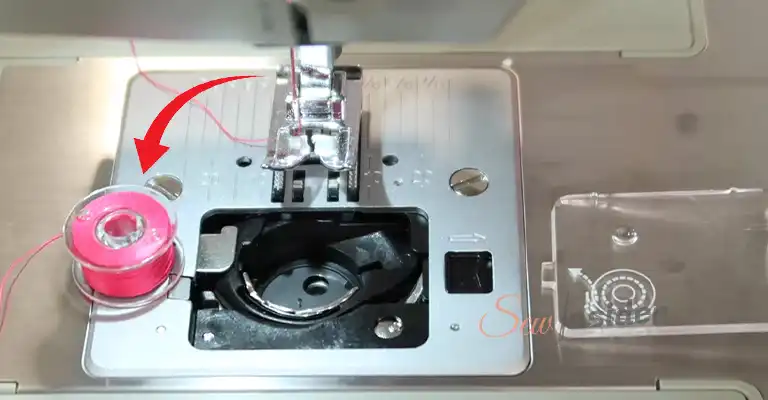
You don’t need to worry if you can’t remember what the instructions are to assemble the bobbin of your White sewing machine since you have lost the documents with the instructions. Most White machines work in much the same way as this one. Taking the bobbin out of the chamber before winding it with a thread of your choice is essential. In this case, threading is a simple process from here.

You can complete sewing projects quickly and easily with a sewing machine, but you must know how to assemble a bobbin first. The bobbin supplies thread to the needle of your sewing machine to create a stitch. Before continuing your project, you’ll need to assemble your thread onto your bobbin once you’ve chosen the line you want to use. It is the same process regardless of which machine you use to assemble a bobbin.
Here Are Some Things You’ll Need
There is a shuttle cover under the needle. Finding the shuttle cover on one side of the machine is possible by finding the metal plate where the hand pushes through with the thread.
In the shuttle cover, you will find the bobbin casing. The cylinder will look like one made of metal and have a twisted shape.
Remove the bobbin by sliding it out. It is necessary to open the case to remove the bobbin.
When you wind the bobbin on your sewing machine, the spool pin holds the thread. The cylindrical piece will fit into the hole in the thread spool. Most machines have spool pins on the top or side.
Once you have secured the line to the spool pin, you can quickly transfer the cord from the spool once you have started the spool or removed the thread end from the hook.
Make sure the spool pin fits through the threaded center. You can hold the line in place with a spool cap. It may not have a spool cap if the spool pin is on top.
You can guide the line with the help of a small hole near the spool, where most machines have a piece for winding bobbins and threading the machine. In the absence of a thread guide on your device, skip this step.
The thread will be conveyed by a small metal piece as it wraps around the bobbin on your device. There is something that looks like a tiny knob on it. This piece should be near the thread guide. Then wrap one around the tension disk. A triangle should form when the thread is taut, with the triangle’s top located at the tension disk. Keep your line tight.
Afterward, release the stop motion knob on your White sewing machine and follow the threading instructions found in the manual. When the bobbin is complete, tighten the stop motion knob and push the bobbin winder spindle according to the manual’s directions. Return the spindle to its original position after winding. Adjust the upper thread guide by releasing the screw on the upper thread guide if there are errors during bobbin winding.
When you replace the bobbin, you remove the removable bobbin case from the machine. There are two types of these: front loading and side loading. Reverse-loading sewing machines are scarce, but a few models exist. You can remove and replace removable bobbin cases by holding a lever or spring.
To load bobbins, remove the front loading cases and insert them on the left side of the sewing machine. On modern devices with removable bobbins, these are the most common.
Bobbin cases that load from the side are very similar to those that load from the front. Side-loading bobbins, however, have a smaller top hole than front-loading bobbins. This hole will receive the needle of your sewing machine.
Important Note for side-loading:
Using a side-loading bobbin case with a front-loading machine is not possible, but it is possible to use a front-loading bobbin case with a side-loading device. Modern sewing machines (after 1980) rarely have these bobbin cases. Kenmore, Singer, and White machines have this style.
Why Isn’t My Sewing Machine Grabbing the Bobbin Thread?
Make sure your bobbin is wound evenly and inserted correctly into your machine. Make sure the bobbin case does not have scratches. To wind the bobbin evenly, pull the bobbin thread completely under tension. Make sure the machine is using the correct bobbin.
Does it Matter Which Way the Bobbin Goes In?
Setting the bobbin should result in the thread unraveling in the correct direction. Incorrect thread tension or needle breakage may result from the line unrolling in the wrong direction. Using a correctly wound threaded bobbin would help. In this case, the needle breaking or the thread tension being incorrect is possible.
Do Bobbins Hold the Bottom Thread in Sewing Machines?
A sewing machine’s bobbins are small plastic or metal spools that hold the thread. Bobbins stores the device’s lower lines. When the top thread comes through the needle, it catches the bottom rope from the bobbin and attaches it to the entire line.
Many sewing machines have similar basic features but vary from model to model. Machine stitching involves inserting an underside thread in the bobbin. Top-drop-in bobbins and front-loading bobbins are both types of bobbins. There is usually no way to interchange it between machines. If you do not use the bobbins recommended by the manufacturer, your Sewing machine may not operate correctly. A proper assembly of the bobbin is also essential to avoid sewing complications.